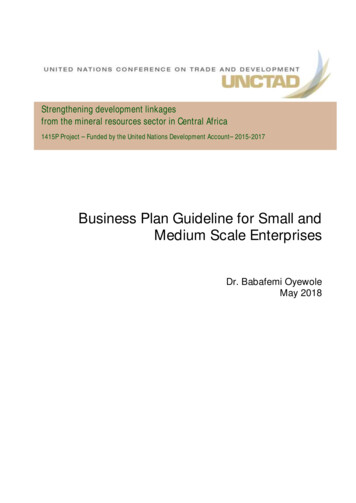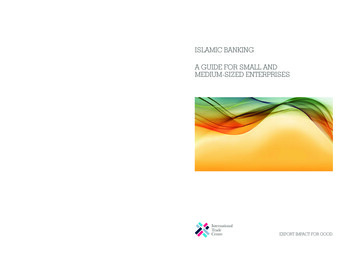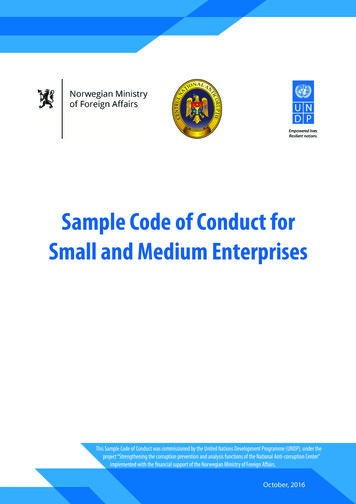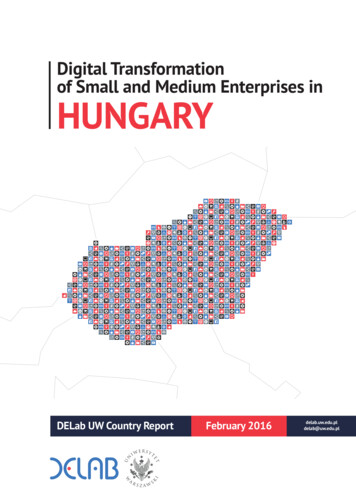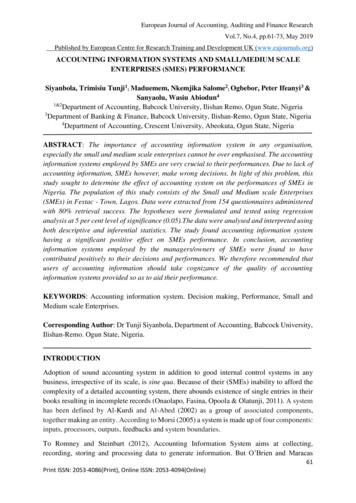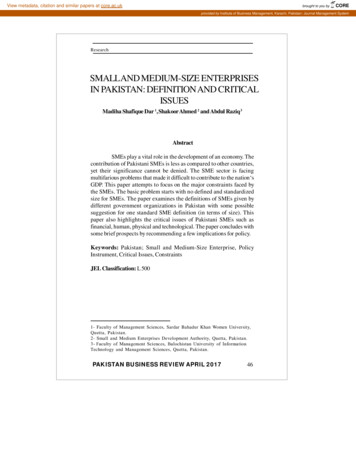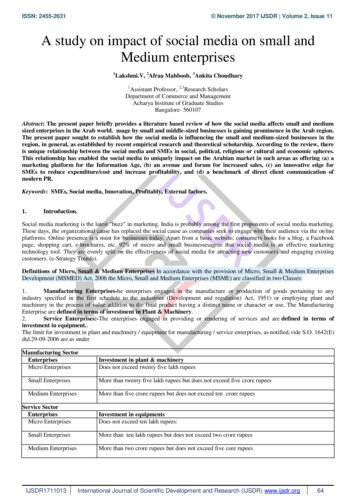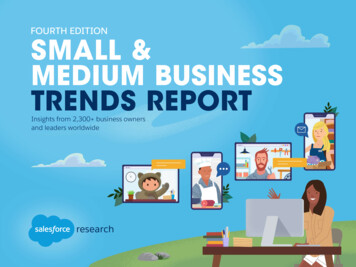
Transcription
FOURTH EDITIONSMALL &MEDIUM BUSINESSTRENDS REPORTInsights from 2,300 business ownersand leaders worldwide
SALESFORCE RESE ARCHS M A L L & M E DI U M B U S I N E S S T R E N D S R E P O R TAbout This ReportFor the fourth edition of the “Small andMedium Business Trends Report,” we analyzedthe responses of more than 2,300 small andmedium business (SMB) owners and leadersaround the world to determine: How a pandemic and racial injustices affecttheir motivations, challenges, and goals How demographics shape entrepreneurialexperiences and outlooks The role of digital transformation in drivingbusiness resiliency How SMB leaders are planning for recoveryand growth post-COVID-19An initial survey was conducted online by TheHarris Poll on behalf of Salesforce betweenFebruary 28 and March 18, 2020 among 2,411SMB owners and leaders, and a follow-up studywas conducted six months later between August7 and 31, 2020 among 2,377 SMB owners andleaders in North America, South America, Europe,and Asia Pacific. Respondents are 18 years of ageor older, employed full-time, part-time, or selfemployed, and owners or senior executivesat their businesses with 2–200 employees andannual revenue of less than 1 billion U.S. orthe local equivalent.*All respondents are third-party panelists (notlimited to Salesforce customers).* See “Demographics” for further breakdownof demographics in this study.Respondents by Region752765252U.S., CanadaBrazilU.K./Ireland, Spain, France, Germany, Italy, NetherlandsIndia, Philippines, Singapore, Thailand, Australia/New ZealandSalesforce Research provides data-driven insights to helpbusinesses transform how they drive customer success.Browse all reports at salesforce.com/research.6082
SALESFORCE RESE ARCHS M A L L & M E DI U M B U S I N E S S T R E N D S R E P O R TSubgroups Shown Throughout This ReportMarchAugustn 1,476n 1,525n 935n 852n 1,616n 823Stagnant/Declining (less than 1%revenue increase or a decline)n 795n 1,554Retailn 366n 337Technologyn 183n 149Manufacturingn 129n 119Hospitality, Travel, Transportationn 129n 112Healthcare Providern 90*n 108Consumer Productsn 88*n 107Lown 401n 389n 1,255n 1,325Highn 693n 616Whiten 405n 391Black/African Americann 31**n 40**Latina/o/xn 43**n 48**Business Size(number of employees)Small (2–20)Business Growth(August — based on revenueover the past 6 months)(March — based on revenueover the past 2 years)Growing (1% or morerevenue increase)IndustrySocioeconomic Status(Based on household income;data breaks calculated based ondistribution around the medianfor each individual country)Race or Ethnicity***(U.S. only)Medium (21–200)Medium* Caution: Small base size (less than 100); results should be interpreted with caution.** Caution: Very small base size (less than 50); results should be interpreted as directional.*** Caution: While other races were surveyed in the U.S., the base sizes for those races weretoo small to be included for quantitative analysis. This table only includes subgroups that wereincluded in this report as indicated by the table title.3Data points were weighted by number ofemployees to bring them into line with actualcompany-size proportions in the population. Thisonline survey is not based on a probability sampleand therefore no estimate of theoretical samplingerror can be calculated.In both the March 2020 and August 2020studies, the following countries were included:U.S., Canada, Brazil, U.K./Ireland, Spain, France,Germany, Italy, Netherlands, India, Philippines,Singapore, Thailand, and Australia/New Zealand.In the 2019 study, also referenced in the report,the following countries were included: U.S., U.K./Ireland, France, Germany, India, Singapore, andAustralia/New Zealand.
SALESFORCE RESE ARCHS M A L L & M E DI U M B U S I N E S S T R E N D S R E P O R TContentsExecutive Summary. 501 SMBs Prioritize Customer Safety and Shift Interactions. 602 SMB Optimism Persists Amid New Challenges. 1103 Digital-Forward SMBs Are Better Equipped to Handle Market Volatility. 1904 Growing SMBs Prepare for Future Crises. 25Country Profiles. 31Appendix. 46Survey Demographics. 494
SALESFORCE RESE ARCHS M A L L & M E DI U M B U S I N E S S T R E N D S R E P O R T5Executive SummaryIn early 2020, the world as we know it changed— first, COVID-19 presented businesses of allsizes with unprecedented challenges. Later in the01year, racial injustices heightened across the U.S.,sparking a movement for change. But leadersof small and medium businesses are builders,SMBs Prioritize Customer Safety and Shift InteractionsEven while SMB owners and leaders are navigating change, customers are top ofmind for SMBs that continue to grow. SMBs are even more strapped than usual fortime and capital, but those best poised for the future are more likely to prioritizeadjustments to their services and interactions to deliver safe customer experiences.Growing businesses are more apt to offer greater customer flexibility andprioritize development of customer relationships.creators, and innovators who are determined topersevere. We asked about their experiences asthey navigate these challenging times, and howthey are adapting for the future.This report examines the evolving outlooks of02SMB owners and leaders, first at the onset of thepandemic in an initial survey conducted in March2020, and then again roughly six months intoSMB Optimism Persists Amid New ChallengesIn addition to pre-pandemic challenges like acquiring new customers and accessingcapital, SMB leaders are now faced with operational restrictions, compliancemandates, and shifting customer expectations. The specific challenges faced differdepending on income and — at least in the case of the U.S. — race. Despite thesemultifaceted challenges, most SMB leaders remain optimistic about the futureof their businesses.COVID-19 in August 2020. By analyzing the results,we uncover key priorities and challenges andlearn how SMB leaders have shifted their businessoperations over time.Here are some of the major trends.0304Digital-Forward SMBs Are Better Equipped to Handle Market VolatilityEffective use of technology can be a differentiator for SMBs. As SMB leaders strategizeways to pivot their businesses and embrace a new era of customer interactions,technology plays a central role in driving growth. Growing SMBs are more likelyto use technologies like customer relationship management (CRM) systems,customer service software, and email marketing software.Growing SMBs Prepare for Future CrisesWhile recovery from the more immediate impacts of COVID-19, such as reduceddemand and reduced revenue, continues to be a top priority, many SMB leadersalso are focused on long-term business resiliency given an uncertain future. Leadersof growing SMBs are more likely to prepare for the future by digitizing three keyareas: customer interactions, workflows, and internal communications.
SALESFORCE RESE ARCH01S M A L L & M E DI U M B U S I N E S S T R E N D S R E P O R TSMBs PrioritizeCustomer Safetyand Shift Interactions6Regardless of their industry, function, orsize, businesses around the globe have beenimpacted by the COVID-19 pandemic. SMBleaders face particular challenges as theyevaluate where to devote scarce resourcesAreas of Focus for SMBs Due to the COVID-19 PandemicTotal64%along their journeys to stability and growth.SMB leaders are particularly placing an61%Safety and sanitation policies(e.g., wiping down physical spacesafter customer/employee usage)69%emphasis on safety and sanitation policiesand complying with local public healthmandates that can shift depending on the59%59%Local public health mandates(e.g., mask requirements)59%volume of COVID-19 cases in their area. Lessof a focus — although still cited by significantnumbers of SMB leaders — are contactlessservices like digital shopping or curbside48%43%Contactless services(e.g., digital shopping/customer service,mobile order, curbside pickup)44%53%pickups and changes to physical layouts.Medium-sized SMBs — which tend to havemore capital and employees — are more likelyLayout of physical stores/offices toensure social distancing (e.g., markingsix-feet spacing in high-traffic areas,capping occupancy capacity)Small BusinessesMedium-Sized Businessesthan their smaller peers to address all of these35%53%areas of concern, except for local public healthmandates, which are garnering similar focusregardless of business size.
SALESFORCE RESE ARCH01SMBs PrioritizeCustomer Safetyand Shift InteractionsS M A L L & M E DI U M B U S I N E S S T R E N D S R E P O R TSMB Leaders Reporting the Following Challengesto Meeting Customer Expectations**% MoreChallengingOver 6 MonthPeriod*53%Meeting customers’ high expectations — a747%Bringing innovative offerings to market13%tall order for SMB leaders facing time andbudget constraints — is difficult even withoutpublic health, economic, and social crises.Basic operations like keeping up with demand46%47%Keeping up with demand-2%and providing a quality product continue to46%be challenges for some SMBs, although toa similar extent than before the pandemic,Personalizing customer engagements21%38%or early in the pandemic for some countries.However, as the pandemic shifts customerbehavior, certain competitive advantages,such as bringing innovative offerings to46%Implementing safety or sanitation measures N/AN/Amarket, personalizing customer engagements,and providing a connected experience, havebecome increasingly difficult to achieve.40%Engaging customers on theirpreferred channels36%39%Providing a quality product40%39%Responding to inquiries quicklyProviding a connected experience(i.e., when a customer complains, not askingthem to repeat their story/not transferringthem to multiple representatives)August 2020March 202038%39%35%11%-3%3%11%* Responses of (August – March) / March.** Major/moderate challenges.
SALESFORCE RESE ARCH01SMBs PrioritizeCustomer Safetyand Shift InteractionsS M A L L & M E DI U M B U S I N E S S T R E N D S R E P O R TMajor/Moderate Challenges to MeetingCustomer Expectations During COVID-19Medium-Sizedvs. Small**47%SMB leaders acknowledge these challenges in861%Bringing innovative offerings to market30%more likelyresponse to changing customer sentiment. AndSalesforce’s most recent Connected Customersurvey confirms these changing customersentiments are real:77% of customers say this41%Keeping up with demandPersonalizing customer engagementsWith their larger and often more establishedproviding a quality product — when striving to35%57%34%Engaging customers on theirpreferred channelspain points — such as providing a connectedexperience, responding to inquiries quickly, or54%38%Implementing safety or sanitation measuresare more likely than smaller businesses to feel34%40%year’s crises should be a catalystfor business improvement*customer bases, medium-sized businesses55%47%32%Providing a quality productdelight and retain customers.56%50%56%51%65%31%Providing a connected experienceSmall Businesses* Connected Customer survey, Salesforce Research, August 2020.Medium-Sized Businesses38%50%32%Responding to inquiries quickly50%** Responses of (Medium-Sized/Small) / Small.
SALESFORCE RESE ARCH01S M A L L & M E DI U M B U S I N E S S T R E N D S R E P O R TSMBs PrioritizeCustomer Safetyand Shift InteractionsCustomer experience continues to beimportant as expectations remain highChanges to Customer Interactionsduring the pandemic, as noted in Salesforce’s(By business growth)most recent Connected Customer survey ofconsumers and business buyers:66% of customers expectcompanies to understand theirunique needs and expectations*SMB leaders are trying to meet theseexpectations; not only are they focusing onTotal55%47%44%We are more careful about our customercommunications (e.g., I am transparentabout what my business is doing tonavigate the pandemic)57%53%49%We have expanded the ways customerscan reach us (e.g., greater presence onsocial media)We offer more flexibility to customers(e.g., we expanded or updated our returnor payment policies or terms and conditions)45%49%41%safety, they’re also making changes to howthey interact with customers amid newrealities. About half of SMB leaders areputting more effort into their customercommunications and expanding the wayscustomers can reach them. In particular,growing businesses are more likely thanstagnant/declining businesses to haveembraced such changes, namely offeringmore flexibility to customers and prioritizingthe development of customer relationships.* Connected Customer survey, Salesforce Research, August 2020.34%37%We have prioritized developing customerrelationships over one-time transactionsGrowing SMBsStagnant/Declining SMBs32%9
SALESFORCE RESE ARCH01S M A L L & M E DI U M B U S I N E S S T R E N D S R E P O R TSMBs PrioritizeCustomer Safetyand Shift InteractionsMedium-sized SMBs, typically better resourcedthan their smaller counterparts, are more likelyChanges to Customer Interactionsto have revamped their customer interactions.(By business size)Specifically, these larger entities are moretransparent about what their business isdoing to navigate the pandemic and are more49%We are more careful about ourcustomer communications63%likely to expand their communication withcustomers on multiple channels.43%We have expanded the ways customerscan reach us52%38%52%We offer more flexibility to customers30%We have prioritized developing customerrelationships over one-time transactionsSmall BusinessesMedium-Sized Businesses40%10
SALESFORCE RESE ARCHS M A L L & M E DI U M B U S I N E S S T R E N D S R E P O R T1102 SMB Optimism PersistsAmid New ChallengesBiggest Challenges SMB Leaders PersonallyFace When Growing Business*Only top five responses shown48%44%Acquiring new customers28%Planning for the long term21%26%Retaining existing customers23%Beyond meeting customer expectations,SMB leaders face many challenges as theirbusinesses continue to operate, often requiringthem to be optimistic, forward-looking,individuals.Even in a roaring economy, like many wereexperiencing in early March, acquiring newcustomers was, by far, the biggest challengeSMB leaders faced in their day to day. It hasonly become more difficult.Other challenges have also become moreprevalent since March, with SMB leadersnow 33%** more likely to have an uphillbattle planning for the long term and13%** more likely to cite trouble retainingexisting customers.25%Financial management24%22%Achieving work-life balanceAugust 202025%* Up to three responses accepted for this question.March 2020** Responses of (August – March) / March.
SALESFORCE RESE ARCH02 SMB Optimism PersistsAmid New ChallengesS M A L L & M E DI U M B U S I N E S S T R E N D S R E P O R TMost Constraining Factors onCurrent SMB Operations*32%Unchanged since before the pandemic, or early31%Money/access to capitalin the pandemic for some countries, the top31%three operational constraints are money/accessto capital, meeting customer expectations, and28%Meeting customer expectationshiring the right talent.28%30%Hiring the right talent23%Finding the right technologyto meet our needs18%21%Establishing/maintaining processes17%20%Retaining/motivating employees19%20%Implementing technology18%16%17%Insufficient time13%8%Other5%7%NoneAugust 2020March 2020* Up to three responses accepted for this question.12
SALESFORCE RESE ARCH02 SMB Optimism PersistsAmid New ChallengesThese long-term pain points are nowcompounded by pandemic-induced challenges,such as reduced revenue (cited by 56% of SMBleaders) or customer demand (cited by 54%of SMB leaders).In addition, about 3 in 5 SMB leaders saylocal mandates to close or limit operationsare threatening the viability of their business(65%) or that compliance with publichealth requirements creates an excessiveS M A L L & M E DI U M B U S I N E S S T R E N D S R E P O R T13Challenges Constraining SMBs Dueto the COVID-19 PandemicReduced revenue56%Reduced customer demand54%Public health mandates38%Supply chain disruptions32%Changing regulations32%Other5%None7%burden (59%).SMB Leaders’ Attitudes About ChangesDuring the COVID-19 Pandemic(% agree)65%Local mandates of forcedclosure or limited operatingcapacity threaten theviability of my business59%Compliance with publichealth requirements createsexcessive burden to theoperability of my business
SALESFORCE RESE ARCHS M A L L & M E DI U M B U S I N E S S T R E N D S R E P O R T02 SMB Optimism PersistsAmid New ChallengesAs SMB leaders adjust to new regulations andpandemic, many are in survival mode, withSMB Leaders Who Say They’re Strugglingto Keep Their Business Afloatmore than half (57%) saying they’re struggling(% agree by industry)procedures implemented during the COVID-19to keep their businesses afloat. SMB leaders inthe consumer products, retail, and hospitality/travel/transportation industries particularly feelthis facturingTechnology14
SALESFORCE RESE ARCHSpotlight:Black Business Ownersin the U.S. Face UniqueChallengesS M A L L & M E DI U M B U S I N E S S T R E N D S R E P O R TActions SMB Leaders Have Taken Against Racial Injustice**(By total and race in the U.S.)23%Total (U.S.)26%46%Making an active effort to trainemployees on more inclusive practices35%19%Race can play a big part in shaping theexperiences for SMB leaders.1in 3 Black SMB leaders inthe U.S. say their race or ethnicityhas been a disadvantage inrunning a business.*And, compared to other races or ethnicities,Black SMB leaders in the U.S. are the most likelyto struggle to obtain the capital and networking22%30%Had conversations regarding raceand diversity in the past 3-4 months28%12%16%48%Taken a public stance regardingracial justice issues20%60%55%18%45%None of theseWhite (U.S.)Black (U.S.)*Latina/o/x (U.S.)*** Multiple responses allowed.contacts that can help grow their business.With a backdrop of recent calls around the U.S.for racial justice, almost half (45%) of U.S. SMBleaders are taking action to address issues of racialinjustice, such as training employees on inclusivepractices, having conversations regarding raceand diversity, and taking a public stance on racialjustice issues. Black SMB leaders* are particularlyactive in this regard.* Caution: Very small base size (less than 50); resultsshould be interpreted as directional.15U.S. SMB Leaders Who Say Their Race or EthnicityIs a Disadvantage in Running a Business(% of U.S. SMB leaders rating their race as a disadvantage by total and race)U.S.9% ofSMBall leadersU.S.6% ofSMBWhiteleadersU.S.34% ofSMBBlackleaders9% ofU.S.Latina/o/xSMB leaders
SALESFORCE RESE ARCH02 SMB Optimism PersistsAmid New ChallengesS M A L L & M E DI U M B U S I N E S S T R E N D S R E P O R T16SMB Leaders’ Optimism About the Futureof Their Businesses(% optimistic by timeframe)Although optimism about the future is downfrom March (80%) as well as from 2019(78%), the majority of SMB leaders who havemade it this far aren’t pessimistic about theirbusinesses’ future. In fact, more than 1 in 5(22%) say they are very optimistic abouttheir businesses’ outlo
customer service software, and email marketing software. 03 Growing SMBs Prepare for Future Crises While recovery from the more immediate impacts of COVID-19, such as reduced demand and reduced revenue, continues to be a top priority, many SMB leaders also are focused on long-te


